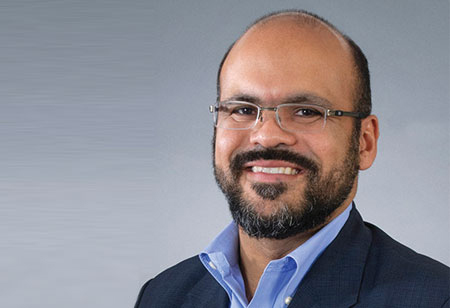Thank you for Subscribing to Healthcare Business Review Weekly Brief

The Modern Day Biomechanics
Healthcare Business Review
Julio Martinez is board certified in Sports Medicine and Physiatry. He is a former athlete treating athletes and is currently involved in innovative multidisciplinary programs including the Baystate Sports Concussion Clinic. He has interest in sports and exercise related injuries, injury prevention performance arts medicine, medical informatics, physician leadership, and medical education of health professionals and the community. In an interview with MedTech Outlook magazine Julio Martinez, Medical Director, Baystate Health discusses about developments in Biomechanics of human motion for Health and Sports.
What are some of the widely prevalent challenges you notice in the Biomechanics landscape?
Biomechanics has a significant influence in the way that we move and also in the way that we participate in sports. Sports injuries occur not only because the patient had trauma but because they may have inappropriate biomechanics. And as a part of our rehabilitation program, we try to identify the part of the patient’s body not moving properly and what we can do to re-educate the patient to help them develop other adequate movements.
One of our main challenges is that some of these evaluations are not medically essential. So they may be considered “experimental.” And that’s one of the challenges because this type of technology is always very expensive and though we may have the service to provide the patient but unfortunately, on some occasions—what we call a cash base of service—it is not something that actually covered by insurance. So one of the main barriers is to identify and apply this type of technology to our workday.
What are the current market trends you see shaping the Biomechanics space?
Specifically on the rehabilitation gait analysis and sports medicine front I see that a lot of the technology that is commonly used now in the movies and video games were initially started in laboratory gait analysis. So we still use induct technology to identify both kinetic and cinematic analysis and as well as try to identify other great body mechanics on patients during gait, running, as well as participating in sports. I will say that computer graphics and motion analysis as well as high speed cameras have been very helpful in pushing that technology to the forefront.
What does the future hold for the Biomechanics landscape?
Recently we started seeing the use of robotic technology to study the biomechanics.
For instance, patients that have spinal cord injuries and for them to ambulate they’re using this type of robotic scaffolding. Basically used in whole body bracing in combination with spinal cord stimulators to try to facilitate patients with spinal cord injuries and be able to ambulate them to be more independent. According to me this is the main feature of the future of biomechanics as I see it in the rehabilitation front.
As a part of our rehabilitation program, we try to identify the part of the patient’s body not moving properly and what we can do to re-educate the patient to help them develop other adequate movements
Also, it is possible that as these types of technologies evolve, they will become less expensive. This type of technology can be applied to potentially industrial athletes to be able to lift heavy objects without the necessity of using robots or using any other type of grains of equipment and can also be used to facilitate training or retraining in case of injury.
What would be the single piece of advice that you could impart to your colleagues to excel in this space?
Don’t be afraid of technology; embrace it and try to learn from it. Because the reality is that it facilitates your practice to being able to interface with different type of technologies. It actually helps communicate with the new generation tools and as well as be easier to accept new technology. In my case I have always been someone that enjoys video games and that actually has exposed me to different technologies which have helped me to embrace new technology; for instance using ultrasound in the evaluation and management of musculoskeletal injuries. Also, we have athletes that have sports concussions and have issues around phobia. I won’t be able to run them by their phone but can direct them to change their phone settings in which they light up the phone which will not be as bright; maybe illumination or blue light to try to promote adequate sleep. So those are minor things that are related to technology that I use almost on a daily basis.
I am seeing that imaging technology have improved significantly in the last 10 or 20 years in which magnetic resonance imaging (MRI) are easily accessible and are used in performing musculoskeletal ultrasound. So there may be other modalities of electronics or technology tools that we’re using for other specialties that may be extrapolated to other uses.









